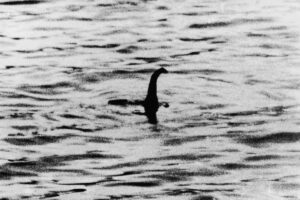 Hunt for the Loch Ness monster by Kayak
Hunt for the Loch Ness monster by Kayak
We offer the best kayak trips on Loch Ness in search of Nessie.
History of Nessie
Saint Columba (565) – Irish monk Saint Columba was staying in the land of the Picts with his companions when he encountered local residents burying a man by the River Ness. They explained that the man was swimming in the river when he was attacked by a “water beast” that mauled him and dragged him underwater despite their attempts to rescue him by boat. Columba sent a follower, to swim across the river. The beast approached him, but Columba made the sign of the cross and said: “Go no further. Do not touch the man. Go back at once.” The creature stopped as if it had been “pulled back with ropes” and fled, and Columba’s men and the Picts gave thanks for what they perceived as a miracle.
An earlier and culturally significant use of Celtic “water beast” folklore along the way. In doing so he also discredits any strong connection between kelpies or water-horses and the modern “media-augmented” creation of the Loch Ness Monster.
D. Mackenzie (1871) – reportedly saw an object resembling a log or an upturned boat “wriggling and churning up the water,” moving slowly at first before disappearing at a faster speed. The account was not published until 1934.
Alexander Macdonald (1888) – sighted “a large stubby-legged animal” surfacing from the loch and propelling itself within fifty yards of the shore. Macdonald reported his sighting to Loch Ness water bailiff Alex Campbell, and described the creature as looking like a salamander.
Aldie Mackay (1933) – The best-known article that first attracted a great deal of attention about a creature was published on 2 May 1933 in Inverness Courier, about a large “beast” or “whale-like fish”. The article by Alex Campbell, water bailiff for Loch Ness and a part-time journalist, discussed a sighting by Aldie Mackay of an enormous creature with the body of a whale rolling in the water in the loch while she and her husband John were driving on the A82 on 15 April 1933.
George Spicer (1933) – Modern interest in the monster was sparked by a sighting on 22 July 1933, when George Spicer and his wife saw “a most extraordinary form of animal” cross the road in front of their car. They described the creature as having a large body (about 4 feet (1.2 m) high and 25 feet (8 m) long) and a long, wavy, narrow neck, slightly thicker than an elephant’s trunk and as long as the 10–12-foot (3–4 m) width of the road. On 4 August 1933 the Courier published a report of Spicer’s sighting. This sighting triggered a massive amount of public interest and an uptick in alleged sightings, leading to the solidification of the actual name “Loch Ness Monster.”
We offer the best kayak trips on Loch Ness in search of Nessie. See us at Visit Loch Ness.
[checkfront category_id=”14″ options=category_select]

Comments are closed